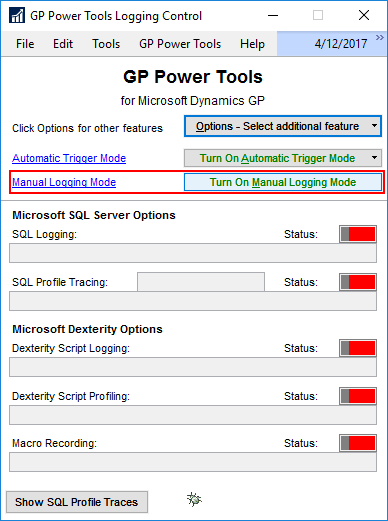 This post is part of the Hands On With the GP Power Tools (GPPT) – System Module series in which I am taking a hands on look at the varioues tools offered by GPPT.
This post is part of the Hands On With the GP Power Tools (GPPT) – System Module series in which I am taking a hands on look at the varioues tools offered by GPPT.
All of the logging modes I covered in the overview are activated by default when Manual Logging Mode is switched on, and this can be done with very few clicks. The Logging Settings window ().
To switch on Manual Logging Mode, open the GP Power Tools Logging Control window from one of the three access points:
- Microsoft Dynamics GP menu >> Tools >> GP Power Tools Logging Control
- GP Power Tools area page >> Transactions >> GP Power Tools Logging Control
- GP Power Tools Logging Control button on the standard toolbar
Click the Turn on Manual Logging Mode button:

The same button is used to switch off Manual Logging Mode.
Each time Manual Logging Mode is activated, the log files contain the user, company, date and time so no log files are overwritten. The log files are created in the GPPT data folder which is selected during the installation of the GP Power Tools.
- DEXSQL_{Date}_{Time}.LOG contains the SQL Logging results.
- Trace_{User}_{Company}_{Date}_{Time}_{Mode}.trc contains the SQL Profile Tracing results.
- Script_{User}_{Company}_{Date}_{Time}.log contains the Dexterity Script Logging results.
- Profile_{User}_{Company}_{Date}_{Time}.txt contains the Dexterity Script Profiling results.
- Macro_{User}_{Company}_{Date}_{Time}.mac contains the Macro Recording results.
{User} will be substituted with the current User ID and {Company} will be substituted with the current Company ID code (InterCompany ID).
{Date}_{Time} will contain the date and time at which the logging was started in the format YYYYMMDD_HHMMSS.
{Mode} will be replaced with a letters A to E depending on the SQL Profile Trace mode used.
Due to the overhead on the processing when the Manual Logging Mode is switched on, it is recommended to minimise the time logging is enabled and also to minimise the amount of information which is captured in the logs. This can be done by getting the user to perform all actions until just before the point at which the issue arises and then enable logging and perform the final actions. Once these actions have been performed and the error produced, switch off the logging.




